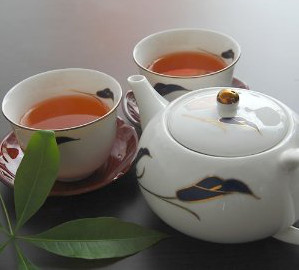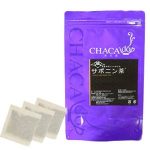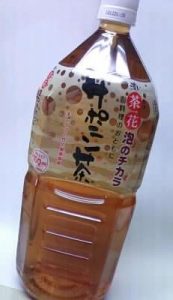 Did you know that there’s a tea that’s mainly drank for its saponin content?
Did you know that there’s a tea that’s mainly drank for its saponin content?
It’s called saponincha (サポニン茶, saponin tea) in Japan, and it’s a real tea in the sense that it comes from the camellia sinensis plant.
If you read my article about saponin, you’ll see that it offers some health benefits. The main one is that it lowers cholesterol absorption.
Unfortunately, this tea is always marketed as a “weight loss tea” which isn’t really what tea lovers are into.
What is saponincha made of?
It turns out that the flowers of the tea plant are rich in saponin. Besides, it contains different types of saponins not found in other parts of the plant: floratheasaponins.
Saponincha is made of tea flowers only. I don’t know about the processing method, I tried searching online but found nothing relevant. Most of the info is hype about how much weight you’ll lose by drinking saponincha 🙂
Different types of saponincha
 On Japanese online stores I saw that saponincha is generally sold in teabags, but there’s also bottled saponincha and an extract in the form of pills (for use as a supplement).
On Japanese online stores I saw that saponincha is generally sold in teabags, but there’s also bottled saponincha and an extract in the form of pills (for use as a supplement).
The teabags also have different brewing instructions. There are personal teabags to brew in a mug with hot water for 3 minutes, and another teabag for brewing a lot of saponincha (1 liter in boiling water for 5 minutes) at the same time.
 I wonder why there’s not more teas made with flowers of the tea plant. Perhaps the taste isn’t that good? Saponin is bitter and astringent, but I haven’t tried saponincha so I don’t really know what it tastes like.
I wonder why there’s not more teas made with flowers of the tea plant. Perhaps the taste isn’t that good? Saponin is bitter and astringent, but I haven’t tried saponincha so I don’t really know what it tastes like.
The saponincha fad in Japan started some years ago, so I’m not sure how the sales are doing now. I found a short video advertising a saponincha brand, although it’s in Japanese.
You probably won’t be able to buy saponincha outside Japan, but at least now you know which tea has the highest saponin content 🙂
Sources:





May 14, 2013
Ricardo, it’s too bad you haven’t tried this tea yourself.
I am curious of how it will taste (I think it will be on the bitter side too).
I also wonder if the tea itself causes froths and bubbles after water is added because of the saponin content.
I doubt I will come across saponincha where I live, but I will definitely keep an eye out for them if I ever go to Japan.
May 14, 2013
Hello Elle
Watch the video and you’ll see that it froths easily!
Hopefully I can try it someday too, then I’ll report about how it tastes like : )
May 17, 2013
Fascinating write-up, Ricardo. I’ve actually had flowers from the tea plant – the Chinese variant, though, not the Japanese. The flowers taste like…well…tea…only more floral. (Obviously.) It’s like a cross between chrysanthemum and Dian Hong, if that makes any sense.
Not sure what the Japanese version would taste like, but I can think of many Chinese ways to have it. Heck, they even make beengchas of the stuff.
May 18, 2013
Thanks for the info, Geoff. I haven’t tried tea flowers yet, hope to do so soon.